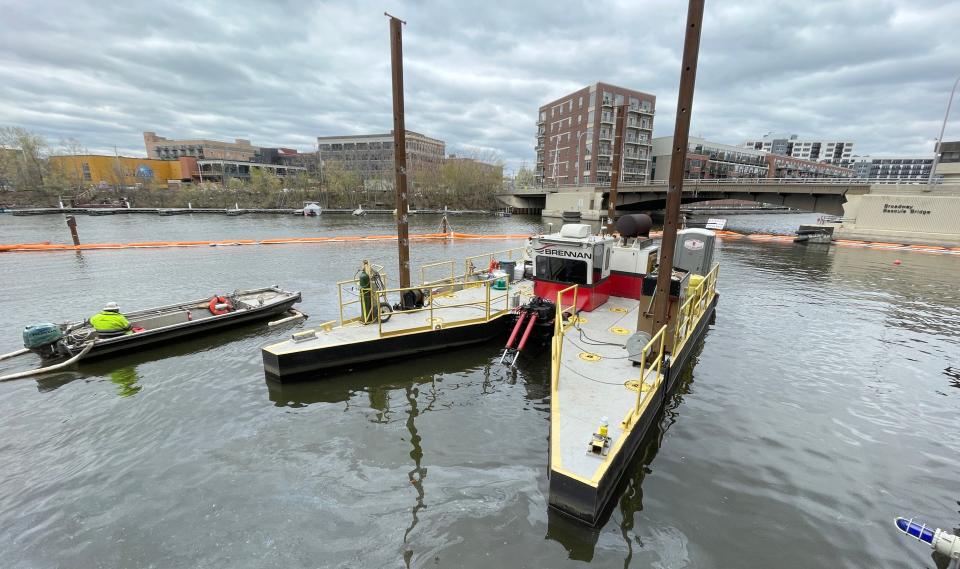EPA Administrator, Tammy Baldwin celebrate funding to clean degraded Milwaukee's waterways
- Oops!Something went wrong.Please try again later.
The administrator of the Environmental Protection Agency and Wisconsin Sen. Tammy Baldwin visited Milwaukee on Thursday to celebrate the historic investment from the bipartisan infrastructure law, which will help clean up Milwaukee's waterways.
The Milwaukee River Estuary − where the Milwaukee, Menomonee and Kinnickinnic rivers meet before heading into Lake Michigan − is one of 25 remaining areas of concern on the U.S. side of the Great Lakes. Areas of concern are the most degraded sites in the Great Lakes basin.

Thursday's event was a victory lap for money secured last year via the bipartisan infrastructure law. The funding provides a billion-dollar boost to the Great Lakes Restoration Initiative − the federal program that funds the cleanup of the areas of concern. The boost is expected to speed up restoration of 22 of the remaining 25 areas of concern by 2030.
The funding will be a win for every community that relies on the Great Lakes, said EPA Administrator Michael Regan at the event, held at Discovery World Science and Technology Museum.
"When you start putting hundreds of millions of dollars into a problem, you're going to solve that problem and you're going to create economic development and opportunities for those communities," he said.
All told, the cleanup efforts to will remove 2 million cubic yards of legacy contamination and restore habitat along 12 total miles of waterway along Milwaukee's three rivers.
Projects to clean up Milwaukee's waterways are already underway. Earlier this year, a project led by We Energies kicked off in the Third Ward to remove contaminated sediment from two sites. The polluted sediment is associated with the operation of Third Ward Manufactured Gas Plant, formerly operated by We Energies' corporate predecessor.
Habitat projects are also underway to clean up waterways for recreation and restore habitat for fish and wildlife. One goal is to create 30 miles of continuous waterway for fish to travel and reproduce by building fish passages along the Milwaukee River. A fish passage around the Kletzsch Park Dam will be completed next month, according to Kevin Shafer, executive director at the Milwaukee Metropolitan Sewerage District. Another will be built around Estabrook Falls.
Milwaukee's sewerage district is also leading a project to build a new facility to store the the remaining contaminated sediment that will be dredged from the waterways. Construction of the facility will begin next spring, and Shafer anticipates the facility will be up and running in two years.
More: Milwaukee is turning around one of the most degraded sites in the Great Lakes. Here's how.
Sediment contamination in Milwaukee's waterways is namely from PCBs, or polychlorinated biphenyls. PCBs are a class of chemicals banned by the federal government in 1979 because they are hazardous to humans, fish and wildlife. However, the chemicals, which are toxic at very low levels, settled into the riverbeds.
These pollutants, along with habitat destruction, have caused 11 beneficial use impairments, or symptoms of pollution, in Milwaukee's waterways. Examples of these include: restrictions on fish consumption, beach closings and loss of habitat.
"Our waterways are sadly degraded by a history of either neglect or board ignorance," said Milwaukee Mayor Cavalier Johnson at the event Thursday. "The legacy of industrial misuse of the Milwaukee River, Menomonee River and Milwaukee's inner harbor impairs our ability to fully enjoy our waterways."
Once the beneficial use impairments have been removed and monitoring efforts show that all restoration targets have been met, the EPA will delist the site.
The Milwaukee area of concern is unique in that there is a community advisory committee overseeing the projects to ensure they meet the goals of the community and that all voices are included.
There are three other areas of concern in Wisconsin: the Lower Green Bay and Fox River that flows into Lake Michigan; the Sheboygan River that also flows into Lake Michigan; and the St. Louis River that flows into Lake Superior. The EPA delisted the Lower Menomonee River area of concern in 2020.
More: Progress seen at Great Lakes' second-largest area of concern, on Minnesota-Wisconsin border
More: A new 'living' breakwater planned help protect Milwaukee's lakefront
Caitlin Looby is a Report for America corps member who writes about the environment and the Great Lakes. Reach her at clooby@gannett.com or follow her on X @caitlooby.
Please consider supporting journalism that informs our democracy with a tax-deductible gift to this reporting effort at jsonline.com/RFA or by check made out to The GroundTruth Project with subject line Report for America Milwaukee Journal Sentinel Campaign. Address: The GroundTruth Project, Lockbox Services, 9450 SW Gemini Dr, PMB 46837, Beaverton, Oregon 97008-7105.
This article originally appeared on Milwaukee Journal Sentinel: EPA leader, Baldwin celebrate funding to clean up Milwaukee waterways

